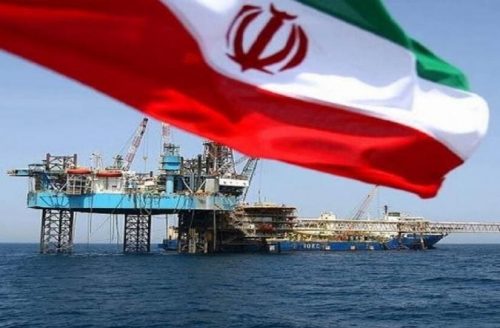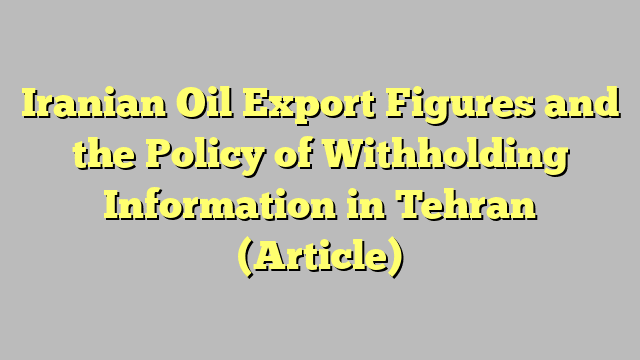Read in this article
- Only official statistics on the value of the country’s exports of oil and petroleum products have been published
- Tehran exports from 420 thousand to 450 thousand barrels of oil products per day
- Iran is in a state of battle.. Even selling one barrel of oil is not normal
- In the current situation, continued sanctions will only benefit interest groups in Iran
During the sanctions period, Tehran was keen to withhold all information and statistics related to Iranian oil sales, and the security approach taken towards circumventing those sanctions led Iranian energy experts to raise this issue for discussion.
Which interest groups benefit from Iranian oil exports during sanctions?
In recent months, government officials have been announcing good conditions for the sale of Iranian oil in the market, and claiming that the amount of oil production and export has reached the level of the era of the nuclear deal, however, the published reports do not confirm this claim.
Referring to the recent report published by the Organization of Petroleum Exporting Countries (OPEC), Reza Badidar, head of the energy committee at the Tehran Chamber of Commerce, said that Iran’s oil sales amounted to about 720,000 barrels per day.
This declared amount is completely inappropriate for a country that has the same amount of oil reserves as Iran.
According to OPEC’s annual report for 2021, Iranian oil export revenues increased by 216% compared to 2020, and the Central Bank of Iran statistics show that this growth was only 40% in 2020.
Iranian Oil Minister Javad Oji says that the growth of oil revenues in the first quarter of this year (2022) amounted to only 50%.
Since the imposition of US sanctions, Iran has kept the volume of its exports of oil and petroleum products hidden, and only official statistics on the value of the country’s exports of oil and petroleum products have been published.
Revenue from Iran’s oil and gas exports
Iran earned about $21 billion in 2020, and according to a report by the Islamic Legislative Council Research Center, the total revenues of Tehran’s exports of oil, gas and gas condensate in 2020 amounted to about $17.5 billion.
Although this report did not publish statistics on exports of petroleum products, Iran exports between 420,000 to 450,000 barrels of oil products per day, with revenues ranging between $11 to $12 billion, according to global oil prices last year.
In 2018 – before the imposition of oil sanctions – Tehran was exporting 2.5 million barrels of oil and gas condensate daily, and about half a million barrels of oil products, and the total income from exporting these products amounted to $62 billion.

Recent statements by some members of the government of Iranian President Ebrahim Raisi show that the government faced a major challenge in meeting its financial requirements, and the head of the Planning and Budgeting Authority announced two months ago that oil sales are not proceeding according to plan.
Referring to the continuation of sanctions, and that it is the most difficult situation for the Iranian oil industry, Oil Minister Javad Auchi said last week that managers should have the courage to make decisions, and they should not be afraid to take them.
According to Javad Ochi, Iran is in a state of battle, and selling even one barrel of oil is not normal.
Iran has great difficulty selling oil and participates in informal markets.
The decline in Iranian oil revenues comes at a time when the Iranian oil industry needs – according to Javad Oji’s statements – investments of more than $150 billion, and more than $70 billion in the field of gas.
This means that in order to increase sales and oil production capacity as much as possible, Tehran needed the income of previous years.
Undoubtedly, defaulting on the joint oil and gas field development program and reducing production creates a backward chain that Iran must compensate.
According to the government’s official statistical reports, income from exporting oil and petroleum products increased more than 11 times last year, and in the first 5 months of 2022, exports increased 8 times compared to the same period last year.
investment needs
Over the past decade, the global oil industry has met less than 50% of investment needs in the upstream and downstream industries, and oil experts in Iran and other countries have raised this issue several times.
Given that the most important concern of the global oil market and the Iranian energy industry in the medium and long term is investment, its absence in this industry will lead to the creation of a large gap between supply and demand.
Oil producers have repeatedly expressed their concerns in international circles.
The OPEC Secretariat recently announced in its World Oil Outlook report that despite the world’s move towards renewable energy, the demand for oil will continue to increase until 2045.
Iranian oil exports
Tehran exported 1 million barrels per day in October 2022, up 300,000 barrels per day month over month, and 100,000 barrels per day above the 12-month average.
The rise in exports was driven by lower prices compared to other regions, which supported purchases from China.
Over the past 3 months, the Islamic Republic has exported between 810,000 and 1.2 million barrels of crude oil and light hydrocarbons per day.
Most of Iran’s oil exports go to companies and institutions in China, in Russia, Venezuela and the UAE, according to research and advisory firms Kepler, Vortex, TankerTrackers and UANI, a nonprofit, nonpartisan political organization based in Washington. United Arab Emirates.
The oil, which is sent to the UAE, is once again exported to the rest of Asia.
These estimated numbers are significantly lower than the 2.7 million barrels of oil that Iran exported in 2018, before the United States withdrew from the Joint Comprehensive Plan of Action and lifted the sanctions.
Although this amount is minor for Tehran, it is much higher than it was during the height of the intense pressure policy practiced by former US President Donald Trump’s administration against the Islamic Republic.
When the exemption period for Iranian oil imports expired in May 2019, oil exports to the Islamic Republic increased to 500,000 barrels per day, or decreased below that.

Sanctions on Iran
Given the recent US sanctions against 13 companies that provided the legal basis for the sale of Iranian-owned petrochemical products in East Asia, the measures aim to exert maximum pressure on the Islamic Republic and minimize the regime’s foreign exchange earnings.
Given the dire state of the Iranian economy, the direct impact of these sanctions should be seen soon.
In the current situation, the continuation of the sanctions will only benefit interest groups in Iran, which also depend on the military forces, especially the Revolutionary Guards.
Moreover, the nuclear negotiations have stalled, and Tehran has witnessed numerous protests in most cities, the past two months.
The Iranian economy will face many challenges until negotiations begin and the signing of the nuclear agreement, and Iran faces a serious challenge to increase its ability to produce oil and gas.
The lack of transparency in the volume of Iranian oil sales, at the time of sanctions, only serves the interests of the groups concerned; Iran does not have much chance of curbing the energy crisis.
* Dr. Omod Shoukry, Senior Advisor on Foreign Policy and Energy Geopolitics, Author of a book “US Energy Diplomacy in the Caspian Basin: Changing Trends for the Last Year 2001“.
*This article represents the opinion of the author, and does not necessarily reflect the opinion of the energy platform.
Also read..

Leave a Reply